The week at a glance
- Pied-billed Grebe still in Greater Manchester
- Green Heron still in Cornwall
- American Coot still in Co Mayo
- American Robin still in Devon
- House Crow still in Co Cork
This time of year can always be a bit quiet, with few new arrivals to entice birders out into the cold. But with the cold weather and snow comes the promise of something a bit different.
For now, the highlights were various remaining Nearctic waifs. The Green Heron continued to show off at the Lost Gardens of Heligan (Cornwall) and the photogenic Pied-billed Grebe stayed at Hollingworth Lake (Manchester) to 21st, just about long enough to tempt BirdGuides' own Stephen Menzie to make the trip and for him to become probably the first birder to dip the bird — the Menzie effect?
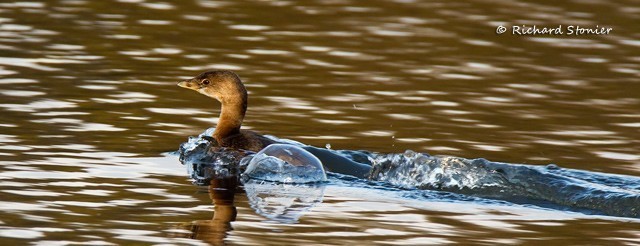
Pied-billed Grebe, Hollingworth Lake CP, Greater Manchester (Photo: Richard Stonier)
Ireland's second American Coot remained at Termoncarragh Loch (Co Mayo) all week and the American Robin at Turf (Devon) just about hung on to 18th. From points east, or points maritime, the House Crow also remained at Cobh (Co Cork) all week.

American Robin, Turf, Devon (Photo: Adrian Davey)
With no reports of Snow Geese this week, the only white geese were a Ross's at Rockcliffe Marsh (Cumbria) to 21st and a Snow or Ross's past Holkham Freshmarsh (Norfolk) on 24th. The Richardson's Canada Goose was still at Loch Gruinart, Islay (Argyll) on 18th and another was with Barnacle Geese at Lissadell (Co Sligo) on 21st. A Lesser Canada Goose at Wigg Island (Cheshire) on 21st was thought to be an escape. There were good numbers of Black Brants reported, including birds at Killala Bay (Co Down) on 18th, Snettisham (Norfolk) on 19th, Portchester (Hampshire) on 20th, Ferrybridge (Dorset) to 21st, Rosslare (Co Wexford) on 22nd; one at Church Norton (West Sussex) on 21st was possibly then at Climping on 21st–23rd. Up to three are now in the Wells-next-the-Sea (Norfolk) area, with a hybrid also in the flock. The feral family of Red-breasted Geese in Suffolk were reported at North Warren on 19th with possibly a more genuine first-winter with Pink-footed Geese at Eccleston (Lancashire) on 23rd.

Red-breasted Goose, Eccleston, Lancashire (Photo: Anthony Oldfield)
Both the Ferruginous Duck and Ring-necked Duck remained at Chew Valley Lake (Somerset) all week. Another Fudge Duck remained at Corbet Lough (Co Down) to 22nd, with Pochard hybrids at Catterall (Lancashire) on 20th and Moor Green Lakes (Berkshire) on 21st. There was also a report of two birds at Ryburn Reservoir (West Yorkshire) on 19th–20th. Other Ring-necked Ducks remained at Bardney Pits (Lincolnshire) to 22nd, Loughrea (Co Galway) to 23rd, with one again at Cork City (Co Cork) on 24th and new birds were at Soulseat Loch (Dumfries & Galloway) and Lough Gur (Co Limerick) on 24th.
Ireland played host to at least seven Green-winged Teal, with five in Scotland; the only English bird was at Eyebrook Reservoir (Leicestershire) on 20th. Also in Ireland, the Blue-winged Teal was again at Bull Island (Co Dublin) to 22nd, with a female at Shannon Airport Lagoon (Co Clare) and a drake at Cabragh Wetlands (Co Tipperary) on 24th.

Green-winged Teal, Inch Island Lake, Donegal (Photo: Dermot Breen)
After a two-week absence the drake Lesser Scaup turned up again in Cardiff Bay (Glamorgan) on 20th–21st. Wales also held on to the female Surf Scoter at Fishguard (Pembrokeshire) on 19th–23rd, with other females off Ruddon's Point (Fife), Murvagh (Co Galway) and Dawlish Warren (Devon), all on 21st, the latter remaining to 24th. With the Suffolk King Eider apparently departed, the only birds reported were the female again at West Voe of Sumburgh (Shetland) on 20th and the drake at Burghead (Moray & Nairn) on 21st. The drake Northern Eider was still at Embo (Highland) on 20th–22nd and another was at Bluemull Sound (Shetland) on 24th. Records of Smew came from 19 sites, including five at Watton NR (East Yorkshire) on 21st and four redheads at Minsmere (Suffolk) on 23rd.

Surf Scoter, Murvey, Galway (Photo: Dermot Breen)
A rather late Cory's Shearwater uncharacteristically headed upstream past Canvey Island (Essex) on 18th before drifting back downstream later the same day. The only Sooty Shearwaters flew past Spurn (East Yorkshire) on 22nd and Kessingland (Suffolk) on 24th. There were similarly few records of Balearic Shearwater: aside from 35 past St Catherine's Breakwater (Jersey) on 20th (with 103 Little Gulls) and two off Branscombe (Devon) on 21st, there were singles past three sites.
The two Glossy Ibis remained on the Otter estuary (Devon) to 23rd, with others at Exminster Marshes (Devon) and Tacumshin (Co Wexford). One was also seen again in flight over the Cotswold Water Park (Wiltshire) on 23rd — this bird was first seen on 5th September, then daily from 18th–28th September, and on the single dates of 8th October, 1st November, 14th November and now 23rd.
Wandering Great White Egrets were seen at several sites in north Norfolk and east Suffolk, and as many as nine other birds were reported, many short-stayers or fly-overs. Single Cattle Egrets remained at Donna Nook (Lincolnshire) to 20th and Guyhirn (Cambridgeshire) to 22nd, with others at Bowling Green Marsh, Topsham and Clyst (Devon) on 19th–24th, Starcross (Devon) on 18th–20th and Grouville Marsh (Jersey) on 19th. No sooner had the Squacco Heron left Angle Bay (Pembrokeshire) than it was replaced by a Cattle Egret, present on 23rd.

Great White Egret, Branton GPs, Northumberland (Photo: John Lang)
In north Norfolk, up to two Rough-legged Buzzards were seen at 10 sites over the week and look set to winter. Elsewhere, there were three in Lincolnshire, three in North Yorkshire, two in East Yorkshire and singletons at Kingfishers Bridge (Cambridgeshire) briefly on 18th and West Yell (Shetland) on 22nd. There was also a report of a probable at High Barnet (London) on 24th. The Northern Harrier remained at Tacumshin (Co Wexford) to 23rd, with the mystery bird in Norfolk, increasingly looking like the real deal, seen around Titchwell, Thornham and Burnham Norton to 24th.
American Golden Plovers remained at Cley (Norfolk) to 21st, Eoropie (Lewis) to 20th and Baleshare (North Uist) to 21st, and the Co Galway juvenile relocated again, this time at Aillebrack on 18th. Other Irish birds were at Ballymacoda (Co Cork) on 20th and Turloughmore (Co Galway) on 20th–24th, with one at Donna Nook (Lincolnshire) briefly on 24th.

American Golden Plover, Turloughmore, Galway (Photo: Dermot Breen)
The lingering Semipalmated Sandpiper was at Ballycotton (Co Cork) to at least 21st and the roving Long-billed Dowitcher stayed put this week, at Lodmoor (Dorset) to 24th. There was a new Lesser Yellowlegs, this time at Rutland Water on 20th–24th. An equally unusual record was a Stone Curlew on North Ronaldsay (Orkney) on 19th — the first record for the island. Also in Scotland, the Dotterel was again at The Wig (Dumfries & Galloway) to 21st. Last of the waders were reports of Grey Phalarope from 14 locations, all of single birds.
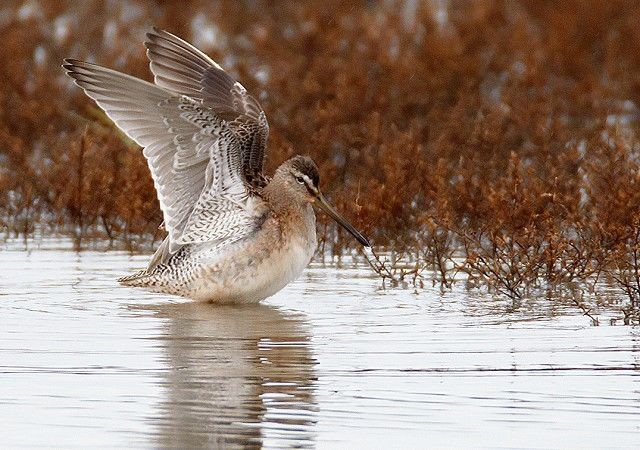
Long-billed Dowitcher, Lodmoor RSPB, Dorset (Photo: Simon Johnson)

Lesser Yellowlegs, Rutland Water, Leicestershire and Rutland (Photo: Bob Pacey)
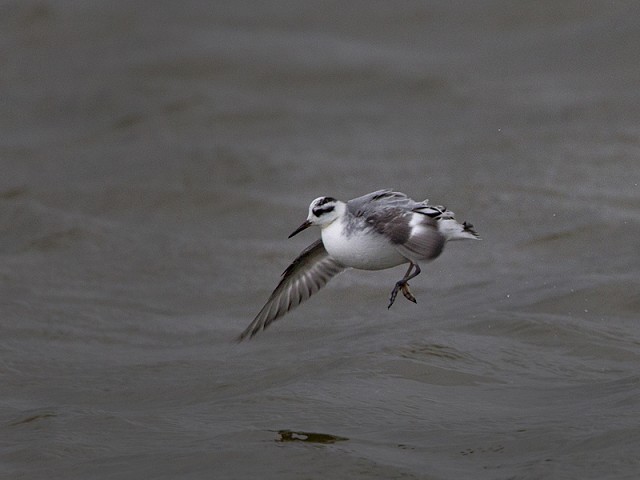
Grey Phalarope, Pett Levels, East Sussex (Photo: Martin Till)
There were just nine Glaucous Gulls and 14 Iceland Gulls reported during the week, although the impending cold snap should bring a few more our way. Long-staying Ring-billed Gulls remained at Gosport (Hampshire), Westcliff-on-Sea (Essex), Oban (Argyll) and Portrush (Co Antrim), with others at Lahinch (Co Clare) and Bell Harbour (Co Clare) on 20th and Limerick on 23rd.
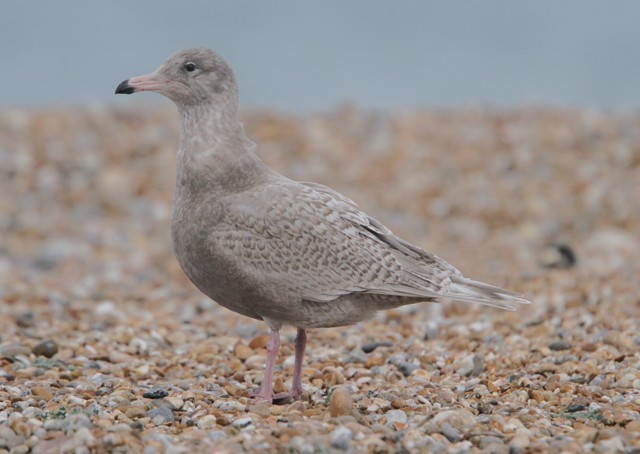
Glaucous Gull, Dungeness, Kent (Photo: Martin Casemore)

Iceland Gull, Preston, Lancashire (Photo: Michael Foley)
Following the departure on 11th of Derbyshire's first Franklin's Gull, those watching the Foremark Reservoir roost on 20th must have been amazed to find a summer-plumaged adult Laughing Gull. This is only the third for the county following birds in 1980 and 1995. This was also the first week of the autumn with no reports of Sabine's Gull. The Co Galway Forster's Tern has settled into its routine now, and was at Nimmo's Pier on 21st–23rd. This is its eighth winter in the area and if past form is anything to go by it should hang around until at least late March or April.
Several now resident groups of Shore Lark remained, with double-figure counts including 20 at Holkham Gap (Norfolk), 15 at Dingle Marshes (Suffolk), 14 at Cley (Norfolk), 13 at Gibraltar Point (Lincolnshire), and 10 at John Muir Country Park (Lothian).
Although there doesn't yet appear to have been a second wave of Waxwings, good numbers are still widely spread, with counts of over 200 in Cumbria, Aberdeenshire, Lothian, Clyde, South Yorkshire, Dumfries & Galloway and a peak count of 400 at Wylam (Northumberland) on 18th.

Waxwing, Bodelwyddan, Clwyd (Photo: Carl Hughes)
The only Richard's Pipits reported were at Barton on Sea (Hampshire) on 22nd and Kynance Cove (Cornwall) on 24th. Following last week's Desert Wheatear in Northumberland, there was a second record this week at Long Nab, Burniston (North Yorkshire) on 19th. It's rather hard to judge, but this bird looks to have a full complement of tertials, whilst the Northumberland bird was missing one on its left wing, so is probably a different bird.

Desert Wheatear, Long Nab, Burniston, North Yorkshire (Photo: Nick Addey)
The late Dusky Warbler remained on St Mary's (Isles of Scilly) to 18th and there was a distinct southerly bias to records of Yellow-browed Warblers, with the only northern bird still at Caerlaverock (Dumfries & Galloway) to 19th. Cornwall recorded birds in Cot Valley, Carminowe, Helston and Mullion, with two on St Mary's (Isles of Scilly) and singletons at Durlston (Dorset), Dawlish Warren (Devon) and Dungeness (Kent). Typical winter fare was a Hume's Leaf Warbler, first heard at Holme NOA (Norfolk) on 22nd then confirmed in the hand on 23rd, staying to at least 24th. There were almost as many Pallas's Warblers, including two in East Yorkshire (at Flamborough Head and Kilnsea), two in Dorset (at Durlston and Portland) and others at Gibraltar Point (Lincolnshire), St. Margaret's at Cliffe (Kent), Beachy Head (East Sussex) and Bardsey Island (Gwynedd).
Many of the autumn's Great Grey Shrikes seem to have filtered inland now, with most in the southern half of the country. Birds were reported from four sites in Hampshire, but this could relate to a smaller number of birds. There were then three in Devon and two in Dorset, Somerset and East Yorkshire. Other singletons were in Oxfordshire, Staffordshire, Glamorgan, Ceredigion, Lancashire and Borders.

Great Grey Shrike, Dod Law, Borders (Photo: Mike Thrower)
A possible Arctic Redpoll was seen briefly in Eye Field at Cley (Norfolk) on 20th and presumably the same then moved to the car park at Salthouse later in the day. Another was still in Shetland, at Scatness on 21st. Interestingly there were more records of Coue's Arctic Redpoll with birds at Sullom and Maywick (Shetland) on 20th, North Ronaldsay (Orkney) on 21st and one remaining at Woodwalton Fen (Cambridgeshire) to 21st.
The male Serin remained on Out Skerries all week, but a better set of photographs showed it was actually sporting a purple ring from BOF (Belgische Ornithologische Federatie), proving its dodgy provenance. Lapland Buntings were still widespread, with the only big counts being 140 in a stubble field at Happisburgh (Norfolk), 26 at Paviland (Glamorgan) and 22 at Gunwalloe (Cornwall). Rustic Buntings are always a pleasure to see, like glorified, subtly painted Reed Buntings, and there were two records this week: one stayed just about long enough to be well photographed at Whitstable (Kent) on 21st, with possibly the same briefly at Rye Harbour (East Sussex) the next day. Last up was a very late autumn record of a Common Rosefinch at St David's (Pembrokeshire) on 23rd.

Rustic Bunting, Whitstable, Kent (Photo: Phil Wallace)
As a late addition, there were several late summer migrants still hanging on, including a Black Tern in West Sussex on 18th, House Martin in Suffolk on 20th, Willow Warbler in Lancashire on 23rd and Wheatear in West Yorkshire on 23rd.
Photo of the Week: 18th–24th November 2010

Common Crane, Spain (Photo:
Jamie MacArthur)
Bird photographer Jamie MacArthur has travelled to some exotic honeypot destinations, including Lesvos, Goa, Gambia and China, and so shooting in Spain is, relatively speaking, on home soil. That said, many UK-based bird photographers have found that Spain can be a superb destination, especially once the dark and dank British winter sets in. A perfect illustration is Jamie's image of a pair of Common Cranes which, although taken in mid-November, looks like a summer scene, with one bird even doing the 'dance' normally associated with springtime. In this classical-style bird image, Jamie has isolated the cranes in perfect pose, with strong eye contact between the two and with the displaying bird mid-flap, with one foot raised off the ground. Warm-toned sunlight bathes the scene and picks out the feather details beautifully. Now, what was the name of that cheap flights company...?
Other notable photos

Little Owl, undisclosed site, Worcestershire (Photo:
Mark Hancox)
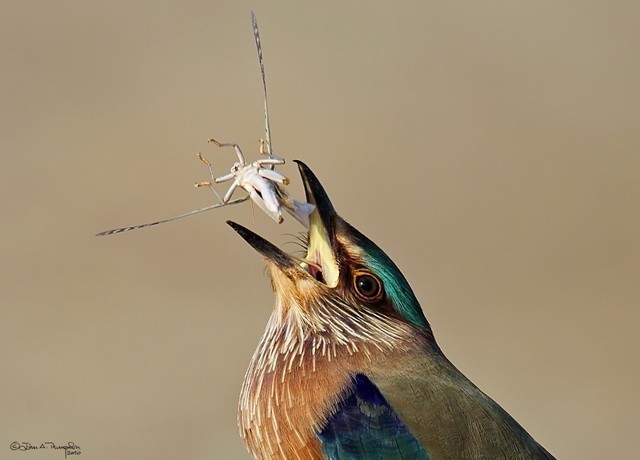
Indian Roller, Oman (Photo:
John A Thompson)
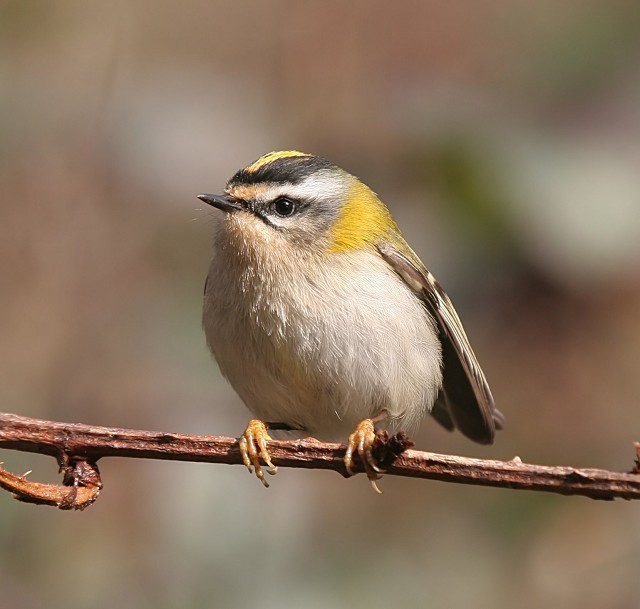
Firecrest, Bosherston Lily Ponds, Pembrokeshire (Photo:
Paul_Leafe)

Peregrine Falcon, Malvern Hills, Worcestershire (Photo:
Carl Day)

Great Northern Diver, Fleetwood, Lancashire (Photo:
Tom Charles)

Glossy Ibis, Budleigh Salterton, Devon (Photo:
John Fielding)

Pied-billed Grebe, Hollingworth Lake CP, Greater Manchester (Photo:
Gary Thoburn)

Merlin, undisclosed site, Argyll (Photo:
Rob Smith)

Cetti's Warbler, UEA Broad, Norfolk (Photo:
Mark Skipper)
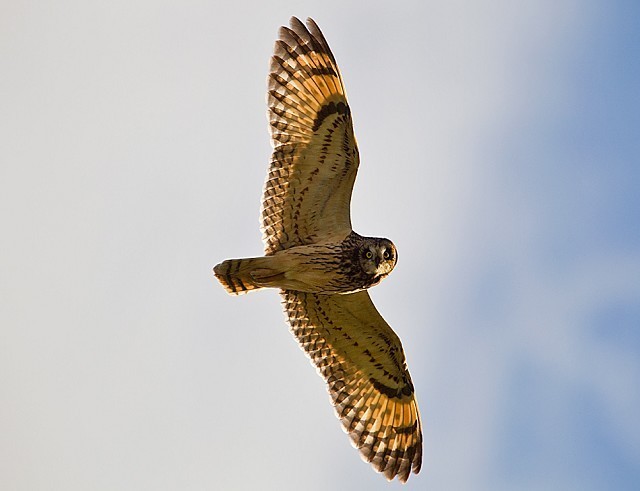
Short-eared Owl, Worlaby Carrs, Lincolnshire (Photo:
Mark Ranner)

Barn Owl, undisclosed site, Lincolnshire (Photo:
Matt Latham)

Buff-crested Bustard, Kenya (Photo:
Kevin Du Rose)

Anhinga, United States (Photo:
Jackie Moreton)

Goldfinch, Chamber's Farm Wood NR, Lincolnshire (Photo:
Nick Clayton)

Purple Sandpiper, undisclosed site, Norfolk (Photo:
Craig Churchill)

Pintail, Martin Mere WWT, Lancashire (Photo:
Paul Hargreaves)
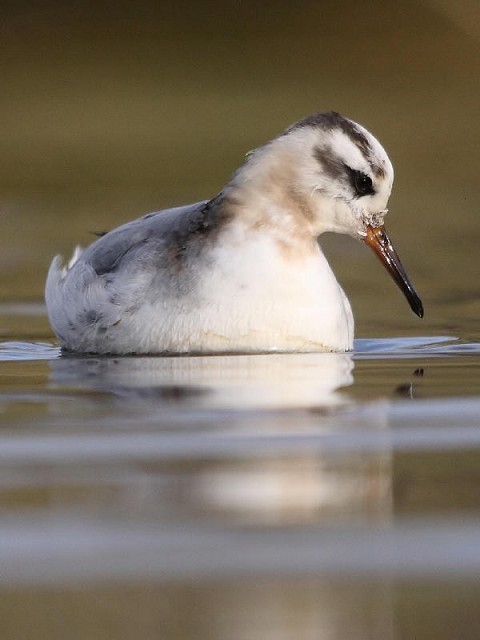
Grey Phalarope, Cononley, North Yorkshire (Photo:
James Thomas)

Crested Tit, undisclosed site, Highland (Photo:
James C Duncan)

Starling, Marton Mere, Lancashire (Photo:
Cliff)
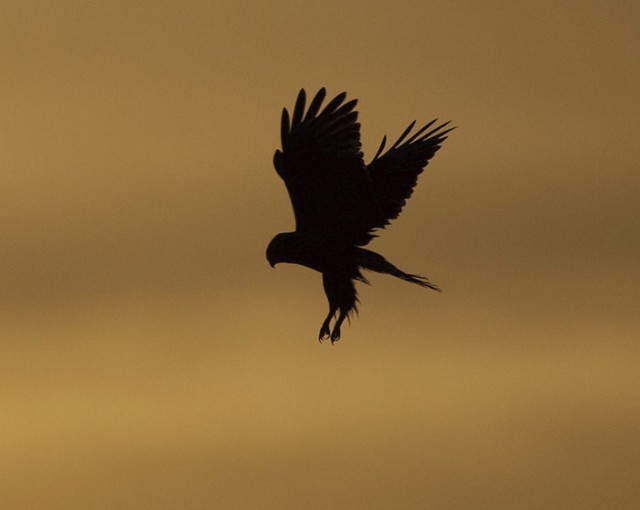
Rough-legged Buzzard, South Ferriby, Lincolnshire (Photo:
Graham Catley)

